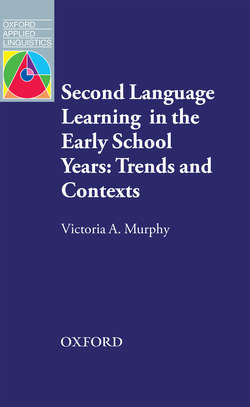Second Language Learning in the Early School Years: Trends and Contexts

Реклама. ООО «ЛитРес», ИНН: 7719571260.
Оглавление
Victoria A. Murphy. Second Language Learning in the Early School Years: Trends and Contexts
Acknowledgements
Preface
1. A typology of contexts
Introduction
Age and L2 learning in primary school children
A typology of L2 contexts
Theoretical approaches underpinning differences in L2 outcomes
Educational implications
Conclusions
2. Bilingual development in young children
Introduction
Defining bilingualism
Bilingual speech processing
Comparisons with monolingual development
Differentiation of the two linguistic systems
Code-switching
Cross-linguistic influence
Dominance
Cognitive effects of bilingualism
The age issue
Educational implications
Conclusions
3. Heritage language learners
Introduction
Who are ‘heritage language learners’? The problem of definition
Sociopolitical context, educational policy, and identity
Incomplete acquisition?
The age issue
Educational implications
Conclusions
4. Minority language learners
Introduction
Vocabulary development in minority language learners
Literacy development in minority language learners
Listening development in minority language learners
Bilingual education and minority language learners
Types of bilingual programme
The age issue
Educational implications
Conclusions
5. Majority language learners: immersion education
Introduction
Immersion programmes
Pedagogical issues
Cognitive effects of immersion
Two-way bilingual programmes
Content and language integrated learning
Immersion gone global
The age issue
Educational implications
Conclusions
6. Instructed foreign language learning in primary school
Introduction
Policy
Provision
Outcomes
The age issue
Educational implications
Conclusions
7. Trends, implications, and conclusions
Introduction
Theoretical assumptions regarding age and L2 learning
Trends across contexts
Educational implications and conclusions
Bibliography
Отрывок из книги
I have hugely enjoyed the process of preparing this volume, and have learned a tremendous amount. I have been so inspired by all the exciting research that is being conducted around the world addressing key issues in the area of child L2 learning and I feel very privileged to be a part of such a vibrant research community.
Most things worth doing are rarely possible without the help and support of a number of people, and writing a book is by no means an exception. There are so many people to thank who supported me throughout the process of putting this volume together that I fear the acknowledgements section itself could be as long as one of the chapters! However, there are some individuals who absolutely must be identified, for without them this book would never have been completed.
.....
The Critical Period Hypothesis (Lenneberg, 1967) has been widely discussed in the context of both L1 and L2 development (see Bialystok and Miller, 1999; Birdsong, 1999; DeKeyser, 2000; Singleton, 2005; Nikolov, 2009; DeKeyser, Alfi-Shabtay, and Ravid, 2010; Muñoz and Singleton, 2011; DeKeyser, 2013). There is considerable variability with respect to how the CPH has been defined and the types of learner and task types that have been researched in respect of the CPH. Consequently, the results are complex and somewhat mixed (Bialystok and Miller, 1999; Singleton, 2005). One of the issues that has been difficult for researchers to pin down is the exact onset and offset of the CPH – when the CPH begins and ends. Lenneberg (1967) originally proposed the onset was around two years old, with the offset around 12 years (corresponding to puberty). This claim initiated a considerable amount of research investigating the extent to which this might be true, both for L1 and L2 (see Herschensohn, 2007). As a consequence of this research effort, almost all of Lenneberg’s original ideas related to the CPH have been refuted (Herschensohn, 2007; see also Snow, 1987). Proponents of the CPH currently argue that the onset is birth, possibly even before birth (see discussion in Chapter 2 on infant speech processing) not two years, and that the offset is likely to be far earlier than puberty, possibly around the age at which typical L1 development is (almost) complete, around 5 or 6 years. Other researchers have argued that age effects in language learning should not be viewed in the constraints of a ‘critical’ period, but rather, opt for the term ‘sensitive’ period to identify that there are no exact cut-off points (Herschensohn, 2007).
There is a wide range of evidence considered supportive of the CPH for L1 development, ranging from neurological studies regarding lateralization of brain function (Penfield and Roberts, 1959), to research on age-of-acquisition effects in deaf children learning to sign, showing that children who learn to sign at younger ages tend to have higher scores on various morphological tasks (Emmorey, 2002; Newport, 1990). There are also compelling and disturbing cases of children who mature in extreme isolation and who fail to develop native-like linguistic competence (Curtiss, 1977; Curtiss, Fromkin, Krashen, Rigler, and Rigler, 2004). Despite research showing these age-of-acquisition effects, the research community has not universally accepted the view that there is a critical period for language development – for either L1 or L2 learning (Bortfield and Whitehurst, 2001; Hakuta, 2001; Snow, 2002). This is because there are a number of variables which are typically confounded with age – such as the nature of the linguistic input (both in terms of quality and quantity), the motivation and aptitude of the learner, and whether the learner receives formal instruction in the L2 – where some researchers have argued that these other variables are more influential in determining differences between young and older learners (Hakuta, Bialystok, and Wiley, 2003).
.....